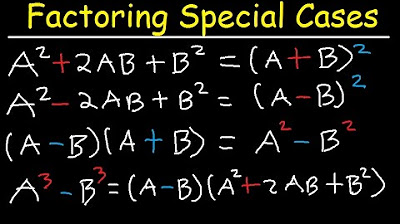Factoring Sum and Difference of Two Cubes: Grade 8 Math
Summary
TLDRIn this lesson, the concept of factoring the difference of two cubes is explored. The video begins by explaining how to identify perfect cubes and their cube roots. Using the formula for sum and difference of cubes, the lesson demonstrates how to factor expressions such as 8x³ + 27y³ and 16u³ - 250v³. The mnemonic 'SOAP' helps remember the signs in the factored form. Additionally, the video explains factoring by grouping with an example of k⁴ - 8k³ - k + 8. By the end, students are equipped with the knowledge to tackle various cube-related factorization problems.
Takeaways
- 😀 Identify cubes by recognizing terms where the exponents are divisible by 3.
- 😀 A cube root of a variable is obtained by dividing its exponent by 3.
- 😀 Example: y^6 is a cube, and its cube root is y^2.
- 😀 The difference of two cubes can be factored into a product of a binomial and a trinomial.
- 😀 Sum of two cubes formula: a^3 + b^3 = (a + b)(a^2 - ab + b^2).
- 😀 Difference of two cubes formula: a^3 - b^3 = (a - b)(a^2 + ab + b^2).
- 😀 Mnemonic for cube factorization: 'SOAP' — Same, Opposite, Always Positive.
- 😀 Example: 8x^3 + 27y^3 can be factored using the sum of cubes formula.
- 😀 Another example: 16u^3 - 250v^3, first factor out the GCF before applying the difference of cubes formula.
- 😀 In cases where the polynomial can't be factored using cubes, consider factoring by grouping, as seen in the final example with k^4 - 8k^3 - k + 8.
Q & A
What is the main topic of the lesson?
-The main topic of the lesson is about understanding and factoring the sum and difference of two cubes.
How can you identify a perfect cube?
-A perfect cube can be identified if the exponent of a variable is divisible by 3, or if a number can be written as a product of the same number three times (e.g., 27 = 3 × 3 × 3 = 3^3).
What is the general rule to find the cube root of a term?
-To find the cube root of a term, divide the exponent of the variable by 3. For example, y^6 has a cube root of y^2 because 6 ÷ 3 = 2.
What formula is used to factor the sum of two cubes?
-The formula to factor the sum of two cubes is: a^3 + b^3 = (a + b)(a^2 - ab + b^2).
What formula is used to factor the difference of two cubes?
-The formula to factor the difference of two cubes is: a^3 - b^3 = (a - b)(a^2 + ab + b^2).
What does the mnemonic 'SOAP' stand for?
-The mnemonic 'SOAP' helps remember the signs in the factorizations: Same sign (as in the middle of the original expression), Opposite sign, and Always positive.
How did the first example factor 8x^3 + 27y^3?
-The first example used the sum of two cubes formula: 8x^3 + 27y^3 = (2x + 3y)(4x^2 - 6xy + 9y^2).
In the second example, why was the greatest common factor (GCF) factored out first?
-The GCF was factored out to simplify the expression before applying the difference of two cubes formula. The GCF in this case was 2, leading to 2(8u^3 - 125v^3).
How was the difference of two cubes used in the second example?
-In the second example, the terms 8u^3 and 125v^3 were factored using the difference of two cubes formula: 8u^3 - 125v^3 = (2u - 5v)(4u^2 + 10uv + 25v^2).
What method was used for the last example involving k^4 - 8k^3 - k + 8?
-The last example used factoring by grouping to simplify the expression. After factoring out common terms, the expression was further factored using the difference of two cubes formula.
Why is it important to recognize when to use the sum or difference of cubes formula?
-Recognizing when to use the sum or difference of cubes formula is crucial for simplifying and factoring polynomials efficiently, helping to break down complex expressions into simpler binomials and trinomials.
Outlines

This section is available to paid users only. Please upgrade to access this part.
Upgrade NowMindmap

This section is available to paid users only. Please upgrade to access this part.
Upgrade NowKeywords

This section is available to paid users only. Please upgrade to access this part.
Upgrade NowHighlights

This section is available to paid users only. Please upgrade to access this part.
Upgrade NowTranscripts

This section is available to paid users only. Please upgrade to access this part.
Upgrade NowBrowse More Related Video
5.0 / 5 (0 votes)





